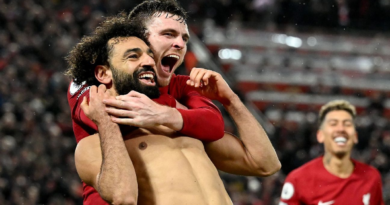Hunter Dickinson: Transfer to KU was a 'basketball decision'
LAWRENCE, Kansas — Hunter Dickinson fidgets with his new, white Adidas shoe, his crossed legs spanning the majority of a leather loveseat inside an office in the famed Allen Fieldhouse.
Dickinson, a 7-foot-1 center and the most coveted transfer athlete to date in college basketball’s new era of player freedom, arrived on the University of Kansas campus a few days earlier. He is wearing a 2022 Kansas national championship T-shirt. Dickinson was the sophomore star of a Michigan team that was bounced in the Sweet 16 that year. His decision to join this KU roster now boosted the Jayhawks from a top 10 team into a prime title contender this upcoming season.
As he tugs at the heel of his new sneakers, he explains that he has never worn Adidas on the court, and he’s had to drop down a size (from 18 to 17) to search for the most comfortable fit. There is nothing else about Dickinson’s life — neither expectations nor opportunities, nor the size of the stage or the size of the bank account — that will be shrinking in his new home.
“He is the most prepared-to-produce player we’ve ever recruited,” said coach Bill Self, who has coached 11 NBA draft lottery picks and eight conference players of the year during his two decades at Kansas. “No one has ever arrived here better prepared to produce or receive accolades.”
Dickinson arrives with proof rather than just potential. He averaged more than 17 points and eight rebounds per game in three seasons at Michigan and was a second-team All-America pick as a freshman. Questions about his ability to defend and his fit as a throwback center in the modern NBA kept him from testing NBA waters after his seasons at Michigan. In the old days of two years ago, his track record through three seasons might have been enough to convince him to leave college as a borderline NBA prospect or play professionally overseas. The ability to make money from name, image and likeness (NIL) deals the past two seasons has helped create a new breed of players — others include Purdue’s Zach Edey, North Carolina’s Armando Bacot and Kentucky’s Oscar Tshiebwe — who have decided it’s a better business decision to develop their games further while taking advantage of star power on basketball-obsessed college campuses rather than rushing to the professional ranks.
“We’ve talked about it. It’s great because it’s really helped keep us back in college,” Dickinson said. “Being a good college basketball player is really fun.”
Dickinson is unique even among that small group because of his decision to transfer to a new school, which set in motion a head-spinning, 34-day recruiting process and a swirl of rumors about the type of money a proven 7-footer can command in the new market for college athletes.
He says he wants to make clear that his choice to play at Kansas was a “basketball decision,” driven by the potential to win championships and by the coaching staff’s reputation for developing and deploying their big men effectively. To the extent that money factored into his thought process while sorting through his options, Dickinson says he was thinking not about any immediate payday but how to maximize his potential to stick around for a long professional career in the NBA after his time in college.
“If I wanted to just go to the highest bidder,” he said, “then it wouldn’t be Kansas.”
The NCAA does not allow overt bidding for players. Schools can tell prospects how much their current players are making in NIL deals and what kind of resources are available to help them cash in on their fame.
Dickinson said Self shared those numbers with him during their first phone call shortly after he entered the transfer portal on March 31, but said he couldn’t make any guarantees about money. Self said they spent most of the conversation talking about how Dickinson would fit into the Jayhawks’ offense and what parts of his game needed to improve if he wanted to reach the NBA.
Coaches and boosters are not allowed to make direct offers to convince a player to attend their school. Dickinson said that didn’t stop many of them from finding creative ways to name a price, some more brazenly than others.
“A lot of them were pretty open with it,” he said, “like, ‘This is what you could get if you came here.'”
Other schools found ways to float numbers through former coaches or trainers who knew the Dickinsons. In some cases, parents who knew the family sent messages to Hunter’s parents explaining how much money some of the players on their son’s team were making. Dickinson and his parents, who spoke to more than a dozen schools during the month-long recruiting process in April, declined to share details about the types of offers they received or the coaches and schools that made them.
“We don’t need any more controversy in our life than what we already have,” said Tim Dickinson, Hunter’s father.
Rock Chalk ! https://t.co/U76y2UwToa
— Hunter Dickinson (@H_Dickinson24) June 2, 2023
Dickinson said he made less than $100,000 in his last year at Michigan. He heard from friends in the sport that other players who were not as impactful on the court were making far more at other schools. While NIL money was not a main deciding factor in going to Kansas, he said, it is part of the reason he left Michigan. His parents said during the recruitment process this spring they were shocked to learn that the earning potential for a player like Dickinson started at a minimum of $500,000.
“I think that would make any normal human being a little upset about their situation,” Dickinson said. “Any guy in some desk job that was working way harder and producing way more than a person at another company that wasn’t producing nearly as much as them but they’re making more money, I feel like any normal human being would be a little upset.”
Dickinson said leaving Michigan was still one of the hardest decisions he’s ever made. He “cried like a baby” when he told head coach Juwan Howard in late March that Michigan’s disappointing season (which ended in a second-round NIT loss) was wearing on him and that he wanted to go elsewhere to finish his college career.
Within minutes of his name officially appearing in the online portal, Dickinson said his phone and his parents’ phones started exploding with calls from coaches. While finishing the academic year at Michigan, he visited five schools (Kansas, Kentucky, Maryland, Georgetown and Villanova) in a super-charged, month-long recruiting process.
Along with more business-like discussions about his future professional prospects and his current earning potential, the month of April also included plenty of old school recruiting hustle. Maryland had a handful of teachers from nearby DeMatha Catholic High School (Dickinson’s alma mater) waiting in the university parking lot to welcome him back home and encourage him to stick around, according to Dickinson’s parents. The family’s flight to Kansas was delayed by several hours, which meant they arrived in Lawrence after midnight. Self was at the airport to pick them up, and the entire coaching staff was waiting at their hotel when they arrived shortly after 2 a.m.
Self, who was not on the sideline for Kansas during the NCAA tournament in March while recovering from a health scare, said he felt “re-energized” by a hectic month of recruiting. Kansas added two other transfers this spring to finish overhauling a roster with only three returning scholarship players.
He said he thinks the new rules will make it easier for high-major teams like Kansas to fill missing pieces on their rosters through the transfer portal each spring, making it less likely that they’ll take big steps backward in any given year. That proved to be the case this season for the Jayhawks. He called Dickinson “the anchor” of an offseason in which the transfer portal treated them “really, really well.”
The veteran coach said he sees pros and cons to the new world of building a college roster. Self said he is concerned that the combination of new transfer rules and NIL money is teaching young athletes the wrong lessons when it comes to fighting through adversity, but he understands that there are cases where moving to a new team is in a player’s best interest.
“I’ve been doing this for a long time and now to keep up with the younger group of players I’ve got to adjust,” he said. “To me, that’s been fun.”
The transfer process was more stressful than fun for Dickinson, who said he’s now happy to be settling into a new campus and getting to know his new teammates during the first weeks of June. Dickinson said he was worn thin by some of the critiques he heard about his decision to leave Michigan, but that ultimately the new doors open to him and others like him — both in terms of opportunities to seek out better spots to develop their skills and the money players can now make in college — are a good step forward for college basketball.
“It’s a multibillion dollar industry. You’ve got coaches making almost $10 million a year. This is not an amateur business,” Dickinson said. “…People might take that the wrong way, like you don’t care and you’re only about money. But I think for me, I look at it as trying to expand and grow in the game of basketball. I’m working out every day to grow my business.”




